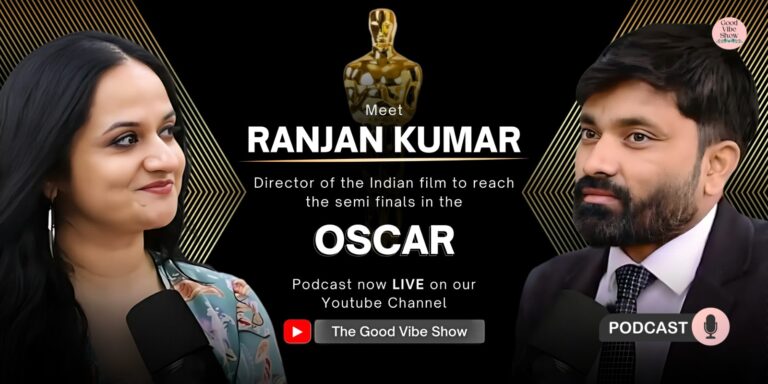Summary:
This special episode of Good Vibe Show comes to you under the open skies, surrounded by fresh air and creative energy. Our guest is filmmaker Ranjan Uma Krishnakumar, whose film “Champaran Mutton” is the first-ever film in the Bajrika dialect (spoken in parts of Bihar) and was a semi-finalist at the Student Academy Awards (Oscars Student Awards). This film isn’t just about “mutton,” but about relationships, desires, struggles, and above all—emotion.
Made as his FTII diploma project, Champaran Mutton was shot with limited resources, regional actors, and a language rarely represented on screen. Ranjan later worked with TVF, learning the discipline of writers’ rooms, and assisted Sanjay Leela Bhansali, experiencing the grandeur of big sets and nuanced storytelling.
For Ranjan, “good cinema” is not about delivering a message—it is about touching the audience deeply, whether through dialogues or silence. He believes regional languages are not just mediums of communication but are repositories of culture and civilization.
In this episode, you’ll hear how the simplicity and struggles of Bihar’s villages shaped his cinematic lens, why characters, story, and emotions all matter (with emotions above all), how he cast actors like Chandan Roy for their rooted authenticity, and what message he has for aspiring filmmakers from small towns:
“Stay connected to your roots, read widely, watch meaningful cinema—and start right now.”
Watch/Listen & Connect
-
🎧 Full Episode: The Journey of Ranjan Uma Krishnakumar – Good Vibe Show
-
🔗 Learn more about Ranjan Kumar
Frequently Asked Questions:
Q1. What makes Champaran Mutton unique?
A. Its biggest distinction is being made in Bajjika, a dialect rarely seen in cinema. A language is not just dialogue—it’s a record of time and society. The film portrays raw emotions from village life—marital tenderness, hunger for small dreams, and rural struggles. That authenticity is what resonates with audiences.
Q2. How was it managed as an FTII diploma project?
A. FTII diploma films are made by a 5-member core team (Direction/Writing, Cinematography, Editing, Sound, Production Design). With very limited budgets, casting, logistics, and technical coordination were constant challenges. At times, the director even had to act himself due to resource gaps. Constraints ultimately made the team sharper and more inventive.
Q3. Is making a film in a regional dialect an advantage or a challenge?
A. Both.
-
Advantage: Authenticity, fresh storytelling textures, and distinctiveness on global platforms.
-
Challenge: Funding, distribution skepticism, and pressure to use “Hindi” or “universal” languages.
Yet, making films in local dialects is also a way of preserving culture.
Q4. What is “good cinema” according to Ranjan?
A. “It need not have a message; it must touch you.” Good cinema leaves you with a smile, a lump in your throat, or a thought that lingers. Characters should stay in memory, emotions should sink in—whether it’s a grand drama or a film with no dialogues at all.
Q5. In storytelling, what matters most—characters, story, or emotions?
A. All three matter, but emotions come first. Characters live in the audience’s mind, the story guides them, but emotions give them meaning. Without emotions, craft may shine but won’t move hearts.
Q6. As an outsider, what’s his take on nepotism?
A. The journey is harder, but talent creates its own path. Ultimately, the industry needs people who can carry stories on their shoulders. Breakthroughs may take time, but consistent learning, writing, and creating bring recognition, regardless of nepotism.
Q7. Why was Chandan Roy chosen as the lead actor?
A. The story is rooted in a village. Ranjan needed someone who felt authentically rural, whose performance didn’t look “performed” but lived. Chandan Roy brought that natural rootedness, making him the perfect fit.
Q8. What advice does he have for aspiring filmmakers/writers?
A. 1. Read widely: From Premchand and Renu to Vinod Kumar Shukla, Nirmal Verma, Tolstoy, and beyond.
2. Watch deeply: From Ray and Ghatak to Malayalam and Iranian cinema—revisit films even if they don’t make sense at first.
3. Stay rooted: Your dialect, soil, and folk stories are your USP.
4. Start small: Short films, documentaries, low-budget experiments.
5. Collaborate: Join writers’ rooms, share scripts, accept criticism—it sharpens your craft.






